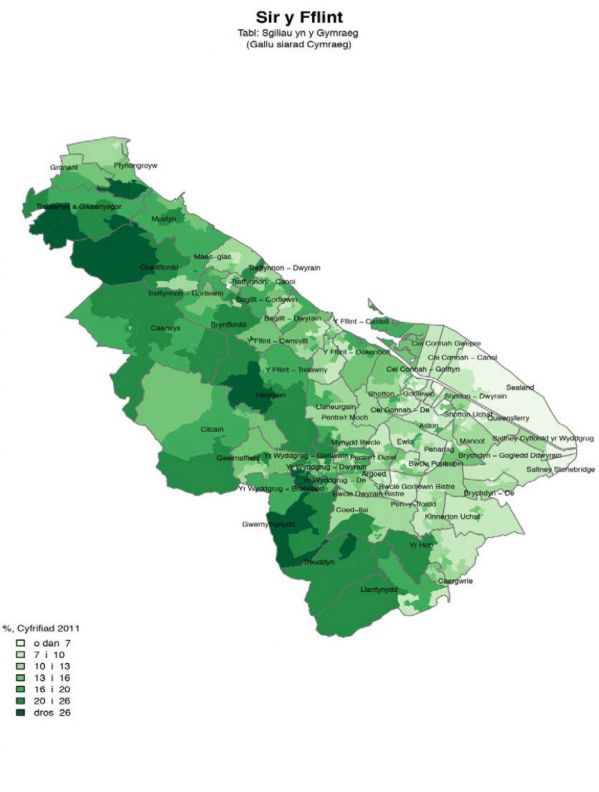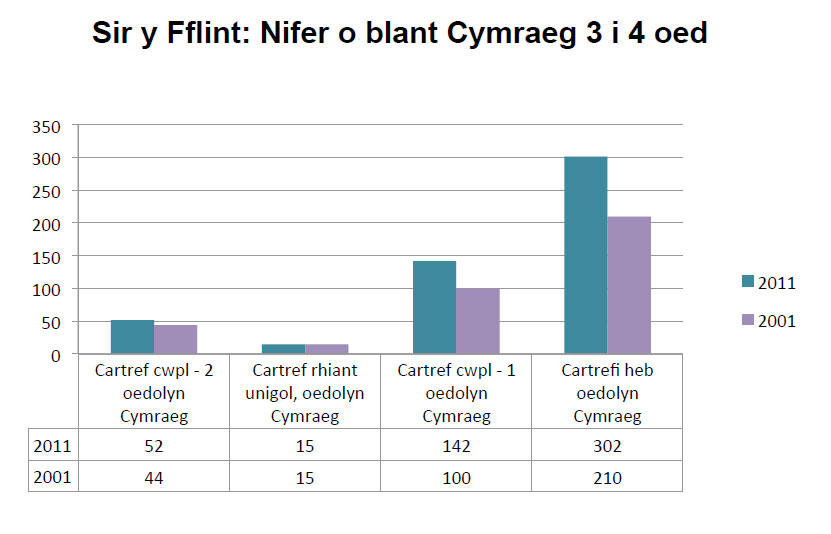Flintshire
(This selection of information comes from ‘Proffil Iaith Gogledd Ddwyrain Cymru (North East Wales Language Profile)’, Cwmni Sbectrwm which was commissioned by the North East Mentrau Iaith in March 2014.)
Location and economy
Flintshire is located in the North East corner of Wales, bordering England. It is one of the least deprived counties in Wales, but there are some pockets of poverty in specific wards. There are prosperous industrial areas within the county, with one of the largest manufacturing sectors in the UK, which includes a range of industries including, Car Manufacturing, Food, Aerospace, Steel and Renewable Energy.
Over the years, rural Flintshire, like many other parts of Wales have seen an economic crisis in those communities dependent upon agriculture. This has threatened the roots of the traditional Welsh communities in the rural area.
The welsh language in Flintshire
2011 Census results show that 19,343 people in Flintshire can speak Welsh, which equates to 13.2% of the county’s population. There has been a decline of 1,256, which is 1.2% in the number of Welsh speakers since the last census in 2001.
2011 Census data show that the highest percentage of Welsh speakers can be found in Mold (South Mold – 30.6%), Trelawnyd (26.2%) and Treuddyn (24.4%).
The map below shows the geographical distribution of the percentage of Flintshire’s Welsh speakers. A clear distinction can be seen between the electoral wards to the west of the county, that have a higher percentage of Welsh speakers, and those to the east, close to the English border.

Source: Comisiynydd y Gymraeg Office
The table below shows the electoral wards with the highest and lowest percentage of Welsh speakers in Flintshire.
| Electoral Division |
% Welsh Speakers 2011 |
|
De’r Wyddgrug |
30.6 |
|
Trelawnyd a Gwaunysgor |
26.2 |
|
Treuddyn |
24.4 |
|
Ffynnongroyw |
22.9 |
|
Chwitffordd |
20.7 |
|
Helygain |
20.7 |
|
Caerwys |
20.3 |
|
Cei Conna Wepre |
9.1 |
|
Canol Cei Conna |
8.7 |
|
Gogledd Ddwyrain Brychdyn |
8.5 |
|
Saltney Cyffordd yr Wyddgrug |
7.8 |
|
Seland |
7.5 |
|
Saltney Stoneybridge |
6.1 |
Age of welsh speakers
People often mistakenly believe Welsh to be the language of old people, but the 2011 Census figures show otherwise, with over 37% of children between the ages of 5-15 able to speak Welsh. The table and graph below shows the distribution of Welsh speakers in Flintshire according to their age.
| Age Group | % Welsh speakers 2001 | % Welsh speakers 2011 | Number of Welsh speakers 2001 | Number of Welsh speakers 2011 |
| Everyone over 3 | 14.4 | 13.2 | 20,599 | 19.343 |
| 3-4 | 10.3 | 14.4 | 382 | 545 |
| 5-9 | 32.7 | 33.1 | 3,138 | 2,768 |
| 10-14 | 42.2 | 38.9 | 4,270 | 3,499 |
| 15-19 | 27.4 | 24.2 | 2,521 | 2,298 |
| 20-24 | 13.8 | 12.8 | 1,082 | 1,152 |
| 25-29 | 12.2 | 10.4 | 1,103 | 892 |
| 30-34 | 9.0 | 11.2 | 1,012 | 938 |
| 35-39 | 8.7 | 10.4 | 1,036 | 1,009 |
| 40-44 | 7.9 | 8.8 | 818 | 1,005 |
| 45-49 | 7.7 | 8.0 | 736 | 939 |
| 50-54 | 7.5 | 7.6 | 857 | 767 |
| 55-59 | 7.7 | 7.1 | 718 | 674 |
| 60-64 | 8.3 | 6.5 | 665 | 721 |
| 65-69 | 9.1 | 7.1 | 581 | 597 |
| 70-74 | 9.8 | 7.0 | 552 | 476 |
| 75-79 | 10.3 | 8.6 | 464 | 426 |
| 80+ | 11.8 | 9.6 | 664 | 637 |

As shown above, the highest percentages that can speak Welsh are in the 5-15 age group. This undoubtedly reflects the influence of the education system on school age children’s language skills. The increase in the 3-4 years age group, from 10.3% to 14.4% is encouraging and shows the possible influence of the extended family introducing the Welsh language to young children, and may reflect the contribution made by the Mudiad Meithrin Welsh medium nursery service.
Welsh language transmission in the home
Language experts across the globe emphasise that it is the lack of language transmission in the home and lack of uses of a language within the family if one of the major factors responsible for the decline of a language, and in this respect, Welsh is no different. The Welsh Government’s Welsh Language Strategy Iaith fyw: iaith byw and a number of projects that the Welsh Government promote emphasise the importance of families in the framework of language planning.
The graph below shows that the number of Welsh speaking children in Flintshire within homes with couples that consist of two adults that can speak Welsh has increased from 44 to 52 since 2001. In homes with single parents that can speak Welsh, the number has stayed the same. The most promising increase in language transmission within the home however can be seen amongst the homes with couples consisting of one Welsh speaking adult, which has increased from 100 in 2001 to 142 in 2011. The increase in homes without any adults that can speak Welsh is also significant – with almost a 100 more children acquiring the language over the last decade.

Source: Comisiynydd y Gymraeg Office
Welsh Education
According to latest figures from Flintshire’s Education Authority, 6.9% of sever year olds are taught through the medium of Welsh at present. Based on teacher assessments, it was judged that 95 pupils spoke Welsh as a first language in 2001 and 113 in 2012. The County Council’s target is to increase this by 2% year on year.
Flintshire County Council conducted the latest survey into the demand for Welsh medium education in April 2009. The survey targeted parents with children 2 years of age and younger at the time of the survey. 22% of respondents stated that they were likely to send their children to local Welsh medium provision currently available, with this increasing to 33% if this was provided within 2 miles of their home.